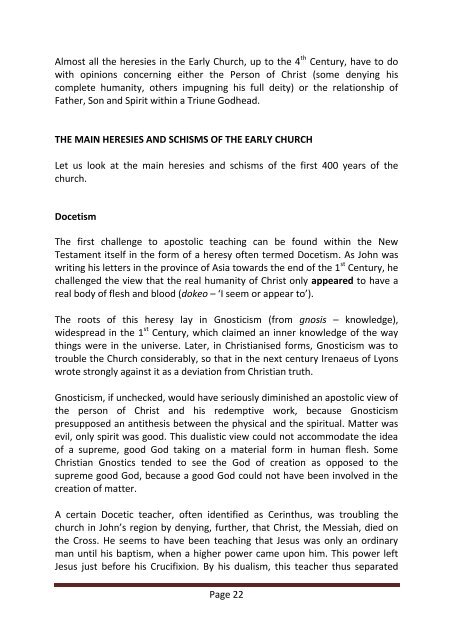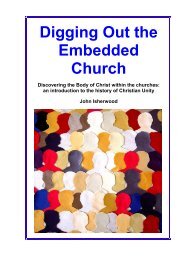- Page 11 and 12: Can Christian Unity be expressed ac
- Page 13 and 14: ‘In the Trinity the three are one
- Page 15 and 16: Protestants, equally, have to be ab
- Page 17 and 18: When John Wesley said that Christia
- Page 19 and 20: (Geneva) Agreed Statement was issue
- Page 21 and 22: While organised Christian endeavour
- Page 23 and 24: Christian Unity consist?’ We shal
- Page 25: CHAPTER 1CHRISTIAN UNITY IN THE EAR
- Page 29 and 30: interpreted as being against the la
- Page 31 and 32: was raised by the Novatian schism.
- Page 33 and 34: ArianismArianism was the most impor
- Page 35 and 36: the Person of Christ. This was the
- Page 37 and 38: Nicaea (325 AD), which asserted, ag
- Page 39 and 40: He wrote:‘The ancient doctrines o
- Page 41 and 42: agreement into the terms and ethics
- Page 43 and 44: authority of the local bishop; Cypr
- Page 45 and 46: Protestants. He was born in Tagaste
- Page 47 and 48: guide the affairs of men: the Papac
- Page 49 and 50: The distinction between laity and c
- Page 51 and 52: ule. Christians were allowed to be
- Page 53 and 54: fallen corruption and mortality but
- Page 55 and 56: During the 1917 Communist Revolutio
- Page 57 and 58: his repentance and restoration. The
- Page 59 and 60: just before death, they might recei
- Page 61 and 62: In both the East and the West heres
- Page 63 and 64: The Waldensians were so named after
- Page 65 and 66: CHAPTER 4THE SECOND GREAT SPLIT: WE
- Page 67 and 68: Far more serious criticisms of the
- Page 69 and 70: and the sacraments. He was tried by
- Page 71 and 72: and his discovering that the Script
- Page 73 and 74: denominational allegiances: confess
- Page 75 and 76: aptism and substituting for it bapt
- Page 77 and 78:
Vincent de Lérins’ threefold bas
- Page 79 and 80:
Charles de Guise, Cardinal of Lorra
- Page 81 and 82:
CHAPTER 5QUOTATIONS ON THE THEME OF
- Page 83 and 84:
Dr Charles Malik - 20 th Century:
- Page 85 and 86:
Nicholas Zernov - 20 th Century:‘
- Page 87 and 88:
The restoration of the universal Ch
- Page 89 and 90:
Timothy Ware - 20 th Century:‘It
- Page 91 and 92:
Basilea Schlink - 20 th Century:‘
- Page 93 and 94:
Cardinal Basil Hume - 20 th Century
- Page 95 and 96:
Keith A Fournier - 20 th Century:
- Page 97 and 98:
concept of a contract between a rul
- Page 99 and 100:
harmoniously ordered society of pea
- Page 101 and 102:
interesting to note that the disput
- Page 103 and 104:
• In the Eucharist, Komensky main
- Page 105 and 106:
The Conference opened with much pom
- Page 107 and 108:
a growing unity among Christians at
- Page 109 and 110:
We cannot leave the 17 th Century w
- Page 111 and 112:
CHAPTER 7CHRISTIAN UNITY AND THE EV
- Page 113 and 114:
In Dr Woodward’s account of the r
- Page 115 and 116:
for Whitefield’s work in America,
- Page 117 and 118:
the West, the North and the South.
- Page 119 and 120:
‘John Wesley, displeased at not b
- Page 121 and 122:
formally, though it may have helped
- Page 123 and 124:
In view of all this, Charles Wesley
- Page 125 and 126:
Some of the refugees were persuaded
- Page 127 and 128:
Isaac Watts (1647-1748), the pionee
- Page 129 and 130:
CHAPTER 8VISIONS OF CHRISTIAN UNITY
- Page 131 and 132:
hymns and Eastern orthodox spiritua
- Page 133 and 134:
eplied with a series of Eirenicons
- Page 135 and 136:
positively wrote on grace and love
- Page 137 and 138:
hand that pours out sorrow’ and t
- Page 139 and 140:
He died in England in 1853 an ‘ec
- Page 141 and 142:
assembly, without much hesitation r
- Page 143 and 144:
‘Loving all whom Christ loves bec
- Page 145 and 146:
says, the Broad Church was ‘a moo
- Page 147 and 148:
far greater part for the laity in t
- Page 149 and 150:
ehind some of the criticism of the
- Page 151 and 152:
came together with the clear purpos
- Page 153 and 154:
In subsequent missionary conference
- Page 155 and 156:
university formed by a federation o
- Page 157 and 158:
credo-baptists to accept the provis
- Page 159 and 160:
Horton Davies 137 points out in his
- Page 161 and 162:
However, since New Delhi, the WCC s
- Page 163 and 164:
(b) The Church of Christ in China (
- Page 165 and 166:
the Scriptures as the supreme autho
- Page 167 and 168:
In 1970 a similar scheme to that of
- Page 169 and 170:
indulgences, were all confirmed str
- Page 171 and 172:
however, at a lower level, manifest
- Page 173 and 174:
In her study of the Evolution of th
- Page 175 and 176:
Even within the Reformed Protestant
- Page 177 and 178:
the publisher’s foreword to Gee
- Page 179 and 180:
and so I have some golden opportuni
- Page 181 and 182:
CHAPTER 10 THESE BRIDGES CAN’T BE
- Page 183 and 184:
‘Only he - only Christ - was able
- Page 185 and 186:
c) Justification by Faith and Works
- Page 187 and 188:
However, in the Credo of the People
- Page 189 and 190:
f) Purgatory‘Purgatory’ is a na
- Page 191 and 192:
The Catechism of the Catholic Churc
- Page 193 and 194:
who love and trust the Lord Jesus C
- Page 195 and 196:
However, there is a growing awarene
- Page 197 and 198:
encouraged to receive a blessing al
- Page 199 and 200:
c) Traduction Œcumenique de la Bib
- Page 201 and 202:
witness. There is one such Sisterho
- Page 203 and 204:
Practically all para-church groups
- Page 205 and 206:
s) Missions and CampaignsMissions a
- Page 207 and 208:
My Protestant friends say to me tha
- Page 209 and 210:
Most Christians, in all three tradi
- Page 211 and 212:
of God may be complete, equipped fo
- Page 213 and 214:
CHAPTER 12NOW WHAT?This book began
- Page 215 and 216:
c) For some Protestants ecumenism m
- Page 217 and 218:
The church at Corinth was full of C
- Page 219 and 220:
) It has become clear that, realist
- Page 221 and 222:
Christians who believe a Catholic d
- Page 223 and 224:
There are three confessions that ha
- Page 225 and 226:
‘The solution to the ecumenical i
- Page 227 and 228:
k) Christ has left us an example -
- Page 229 and 230:
day’, the Niceno-Constantinopolit
- Page 231 and 232:
APPENDIX 2FOUR BIBLICAL TEXTS ON TH
- Page 233 and 234:
of the common good, and when one’
- Page 235 and 236:
eaten, as idols did not exist anywa
- Page 237 and 238:
14. That to continue in any known s
- Page 239 and 240:
What all three traditions have in c
- Page 241 and 242:
Calvin held that the Gospel of Jesu
- Page 243 and 244:
Relations between Protestantism, Ca
- Page 245 and 246:
Brandreth, Henry, R T, The Oecumeni
- Page 247 and 248:
Hopko, Thomas, All the Fullness of
- Page 249 and 250:
Rupp, E G and Drewery, Benjamin, Ma
- Page 251 and 252:
INDEXAAct of Uniformity, 114aggiorn
- Page 253 and 254:
Frame, John M, 91, 187Francis of As
- Page 255 and 256:
Richardson, Paul, 239Roman Catholic








